MREGC5001: Terotechnology Report on Capital Investment Analysis
VerifiedAdded on 2023/01/12
|14
|1918
|25
Report
AI Summary
This report delves into the concept of Terotechnology, focusing on capital investment, asset lifecycle costing, and investment appraisal techniques. It begins with an introduction to capital investment and its evaluation, followed by a detailed explanation of Terotechnology as a method for assessing the profitability and economic benefits of assets throughout their lifecycle, considering associated costs like maintenance and repairs. The report uses Soon Mining Limited as a case study, analyzing its capital assets and highlighting gaps in lifecycle costing practices. It includes practical examples and calculations related to investment valuation, such as present worth, annual worth, and internal rate of return (IRR) for different automation degrees. The report concludes with recommendations for improving capital investment strategies, emphasizing the importance of cost-benefit analysis and efficient asset management. References and an appendix with additional financial data are also included.
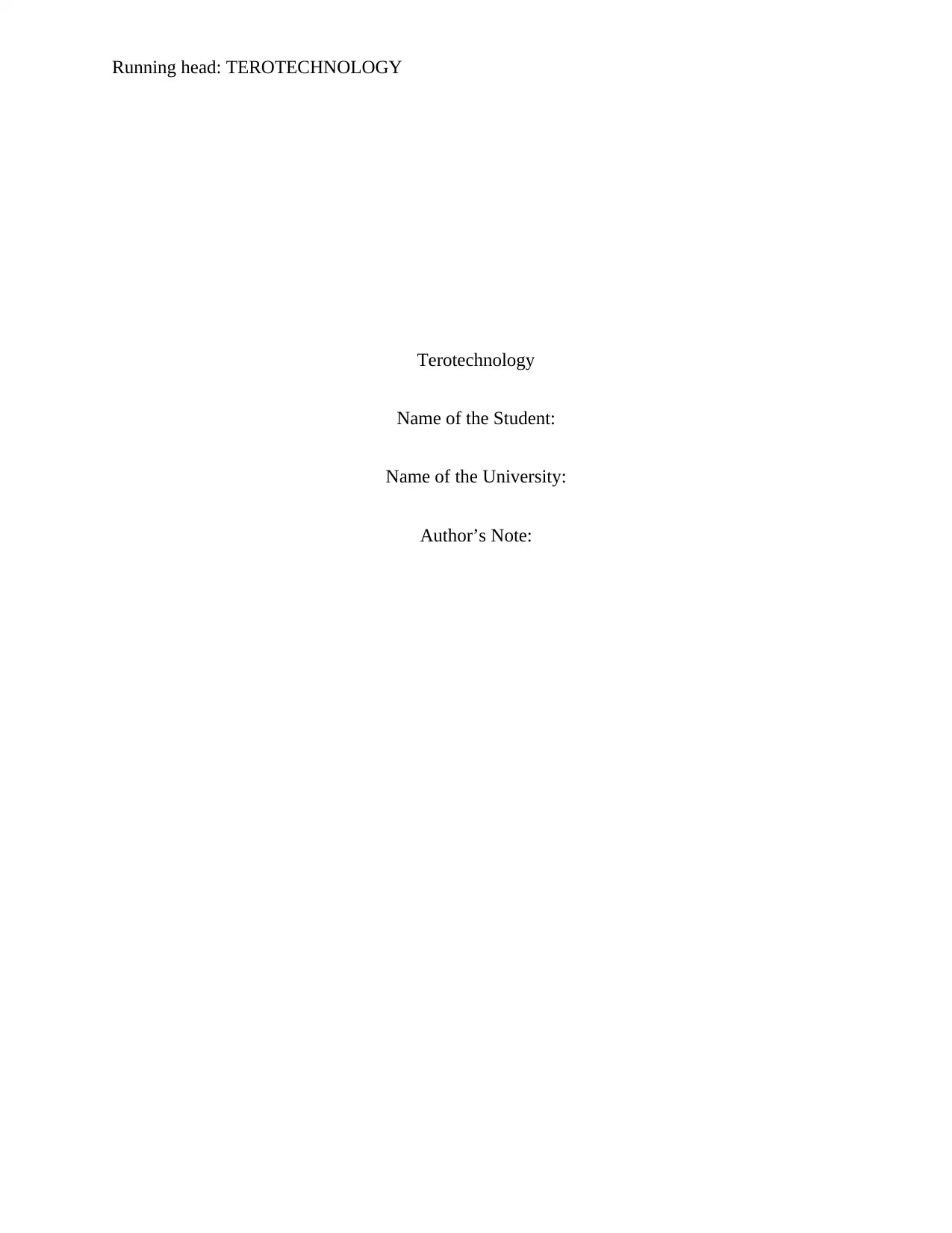
Running head: TEROTECHNOLOGY
Terotechnology
Name of the Student:
Name of the University:
Author’s Note:
Terotechnology
Name of the Student:
Name of the University:
Author’s Note:
Paraphrase This Document
Need a fresh take? Get an instant paraphrase of this document with our AI Paraphraser
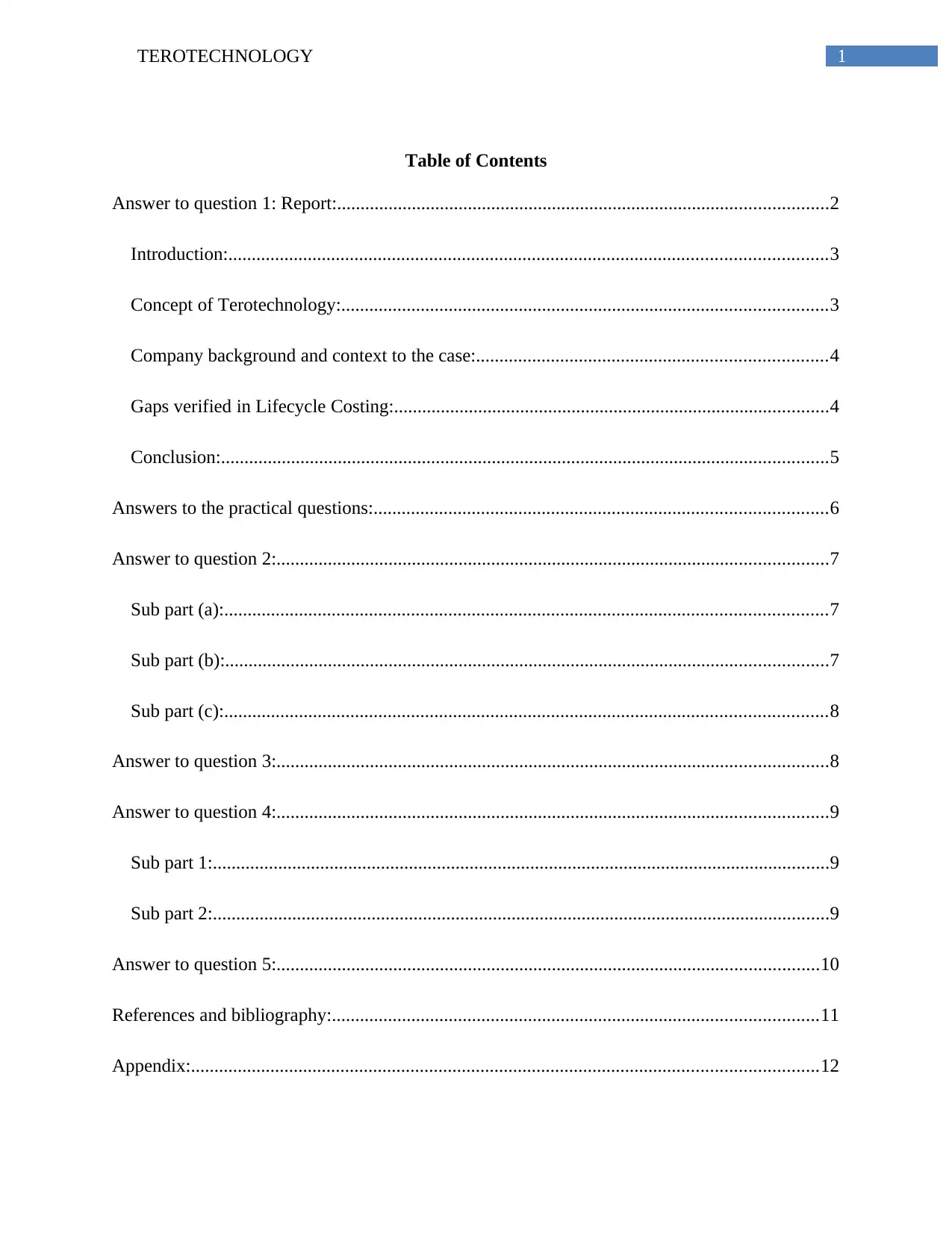
1TEROTECHNOLOGY
Table of Contents
Answer to question 1: Report:.........................................................................................................2
Introduction:................................................................................................................................3
Concept of Terotechnology:........................................................................................................3
Company background and context to the case:...........................................................................4
Gaps verified in Lifecycle Costing:.............................................................................................4
Conclusion:..................................................................................................................................5
Answers to the practical questions:.................................................................................................6
Answer to question 2:......................................................................................................................7
Sub part (a):.................................................................................................................................7
Sub part (b):.................................................................................................................................7
Sub part (c):.................................................................................................................................8
Answer to question 3:......................................................................................................................8
Answer to question 4:......................................................................................................................9
Sub part 1:....................................................................................................................................9
Sub part 2:....................................................................................................................................9
Answer to question 5:....................................................................................................................10
References and bibliography:........................................................................................................11
Appendix:......................................................................................................................................12
Table of Contents
Answer to question 1: Report:.........................................................................................................2
Introduction:................................................................................................................................3
Concept of Terotechnology:........................................................................................................3
Company background and context to the case:...........................................................................4
Gaps verified in Lifecycle Costing:.............................................................................................4
Conclusion:..................................................................................................................................5
Answers to the practical questions:.................................................................................................6
Answer to question 2:......................................................................................................................7
Sub part (a):.................................................................................................................................7
Sub part (b):.................................................................................................................................7
Sub part (c):.................................................................................................................................8
Answer to question 3:......................................................................................................................8
Answer to question 4:......................................................................................................................9
Sub part 1:....................................................................................................................................9
Sub part 2:....................................................................................................................................9
Answer to question 5:....................................................................................................................10
References and bibliography:........................................................................................................11
Appendix:......................................................................................................................................12
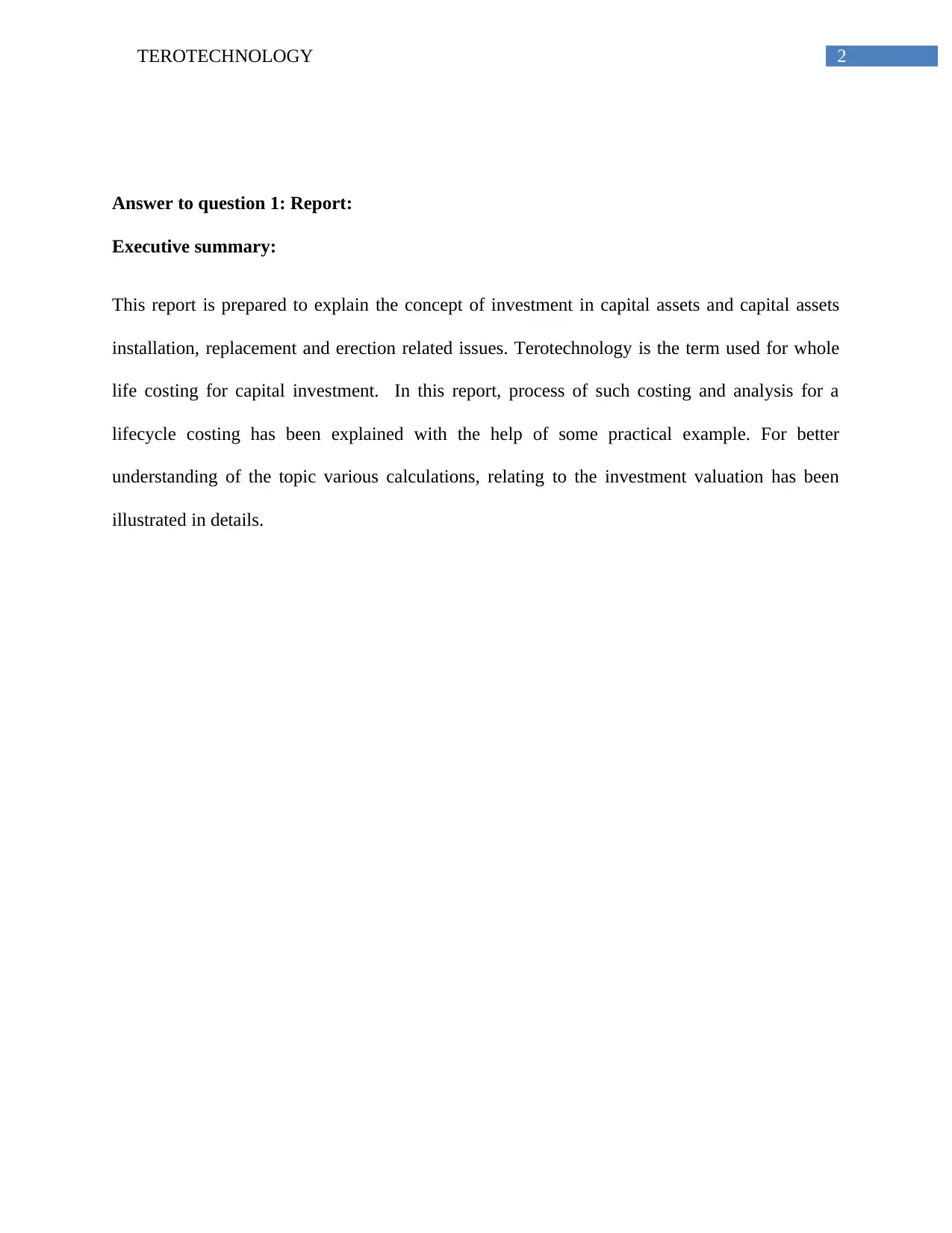
2TEROTECHNOLOGY
Answer to question 1: Report:
Executive summary:
This report is prepared to explain the concept of investment in capital assets and capital assets
installation, replacement and erection related issues. Terotechnology is the term used for whole
life costing for capital investment. In this report, process of such costing and analysis for a
lifecycle costing has been explained with the help of some practical example. For better
understanding of the topic various calculations, relating to the investment valuation has been
illustrated in details.
Answer to question 1: Report:
Executive summary:
This report is prepared to explain the concept of investment in capital assets and capital assets
installation, replacement and erection related issues. Terotechnology is the term used for whole
life costing for capital investment. In this report, process of such costing and analysis for a
lifecycle costing has been explained with the help of some practical example. For better
understanding of the topic various calculations, relating to the investment valuation has been
illustrated in details.
⊘ This is a preview!⊘
Do you want full access?
Subscribe today to unlock all pages.

Trusted by 1+ million students worldwide
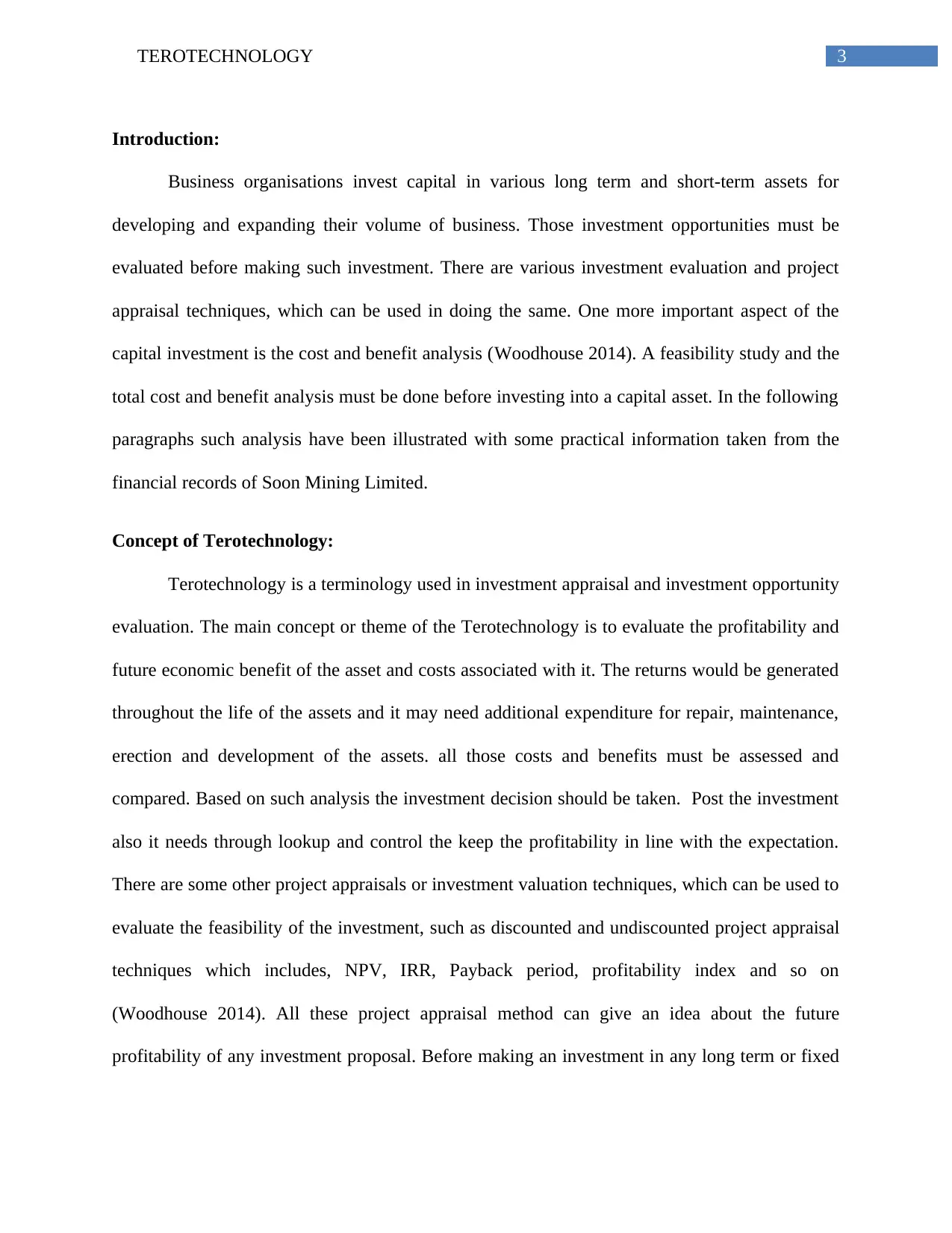
3TEROTECHNOLOGY
Introduction:
Business organisations invest capital in various long term and short-term assets for
developing and expanding their volume of business. Those investment opportunities must be
evaluated before making such investment. There are various investment evaluation and project
appraisal techniques, which can be used in doing the same. One more important aspect of the
capital investment is the cost and benefit analysis (Woodhouse 2014). A feasibility study and the
total cost and benefit analysis must be done before investing into a capital asset. In the following
paragraphs such analysis have been illustrated with some practical information taken from the
financial records of Soon Mining Limited.
Concept of Terotechnology:
Terotechnology is a terminology used in investment appraisal and investment opportunity
evaluation. The main concept or theme of the Terotechnology is to evaluate the profitability and
future economic benefit of the asset and costs associated with it. The returns would be generated
throughout the life of the assets and it may need additional expenditure for repair, maintenance,
erection and development of the assets. all those costs and benefits must be assessed and
compared. Based on such analysis the investment decision should be taken. Post the investment
also it needs through lookup and control the keep the profitability in line with the expectation.
There are some other project appraisals or investment valuation techniques, which can be used to
evaluate the feasibility of the investment, such as discounted and undiscounted project appraisal
techniques which includes, NPV, IRR, Payback period, profitability index and so on
(Woodhouse 2014). All these project appraisal method can give an idea about the future
profitability of any investment proposal. Before making an investment in any long term or fixed
Introduction:
Business organisations invest capital in various long term and short-term assets for
developing and expanding their volume of business. Those investment opportunities must be
evaluated before making such investment. There are various investment evaluation and project
appraisal techniques, which can be used in doing the same. One more important aspect of the
capital investment is the cost and benefit analysis (Woodhouse 2014). A feasibility study and the
total cost and benefit analysis must be done before investing into a capital asset. In the following
paragraphs such analysis have been illustrated with some practical information taken from the
financial records of Soon Mining Limited.
Concept of Terotechnology:
Terotechnology is a terminology used in investment appraisal and investment opportunity
evaluation. The main concept or theme of the Terotechnology is to evaluate the profitability and
future economic benefit of the asset and costs associated with it. The returns would be generated
throughout the life of the assets and it may need additional expenditure for repair, maintenance,
erection and development of the assets. all those costs and benefits must be assessed and
compared. Based on such analysis the investment decision should be taken. Post the investment
also it needs through lookup and control the keep the profitability in line with the expectation.
There are some other project appraisals or investment valuation techniques, which can be used to
evaluate the feasibility of the investment, such as discounted and undiscounted project appraisal
techniques which includes, NPV, IRR, Payback period, profitability index and so on
(Woodhouse 2014). All these project appraisal method can give an idea about the future
profitability of any investment proposal. Before making an investment in any long term or fixed
Paraphrase This Document
Need a fresh take? Get an instant paraphrase of this document with our AI Paraphraser
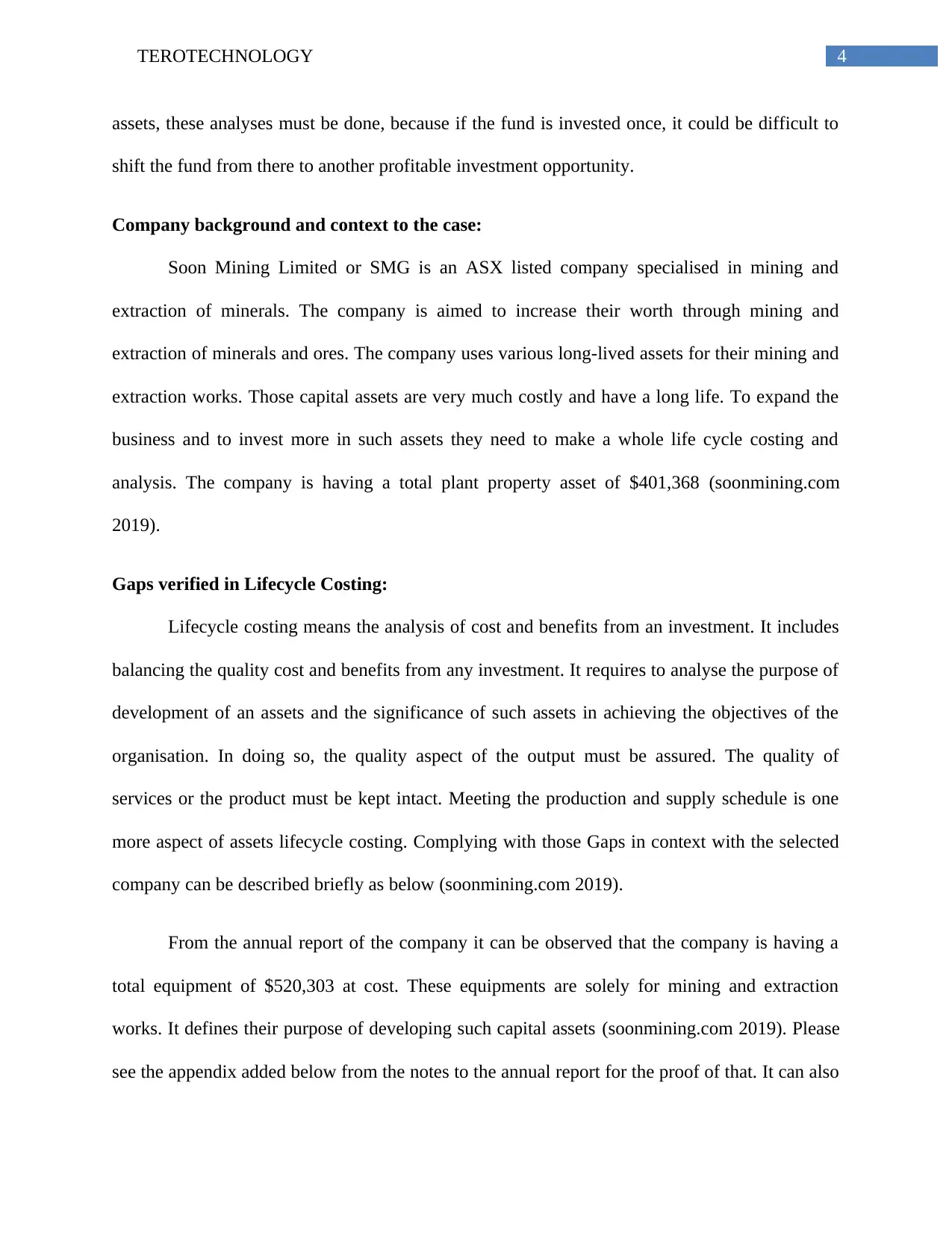
4TEROTECHNOLOGY
assets, these analyses must be done, because if the fund is invested once, it could be difficult to
shift the fund from there to another profitable investment opportunity.
Company background and context to the case:
Soon Mining Limited or SMG is an ASX listed company specialised in mining and
extraction of minerals. The company is aimed to increase their worth through mining and
extraction of minerals and ores. The company uses various long-lived assets for their mining and
extraction works. Those capital assets are very much costly and have a long life. To expand the
business and to invest more in such assets they need to make a whole life cycle costing and
analysis. The company is having a total plant property asset of $401,368 (soonmining.com
2019).
Gaps verified in Lifecycle Costing:
Lifecycle costing means the analysis of cost and benefits from an investment. It includes
balancing the quality cost and benefits from any investment. It requires to analyse the purpose of
development of an assets and the significance of such assets in achieving the objectives of the
organisation. In doing so, the quality aspect of the output must be assured. The quality of
services or the product must be kept intact. Meeting the production and supply schedule is one
more aspect of assets lifecycle costing. Complying with those Gaps in context with the selected
company can be described briefly as below (soonmining.com 2019).
From the annual report of the company it can be observed that the company is having a
total equipment of $520,303 at cost. These equipments are solely for mining and extraction
works. It defines their purpose of developing such capital assets (soonmining.com 2019). Please
see the appendix added below from the notes to the annual report for the proof of that. It can also
assets, these analyses must be done, because if the fund is invested once, it could be difficult to
shift the fund from there to another profitable investment opportunity.
Company background and context to the case:
Soon Mining Limited or SMG is an ASX listed company specialised in mining and
extraction of minerals. The company is aimed to increase their worth through mining and
extraction of minerals and ores. The company uses various long-lived assets for their mining and
extraction works. Those capital assets are very much costly and have a long life. To expand the
business and to invest more in such assets they need to make a whole life cycle costing and
analysis. The company is having a total plant property asset of $401,368 (soonmining.com
2019).
Gaps verified in Lifecycle Costing:
Lifecycle costing means the analysis of cost and benefits from an investment. It includes
balancing the quality cost and benefits from any investment. It requires to analyse the purpose of
development of an assets and the significance of such assets in achieving the objectives of the
organisation. In doing so, the quality aspect of the output must be assured. The quality of
services or the product must be kept intact. Meeting the production and supply schedule is one
more aspect of assets lifecycle costing. Complying with those Gaps in context with the selected
company can be described briefly as below (soonmining.com 2019).
From the annual report of the company it can be observed that the company is having a
total equipment of $520,303 at cost. These equipments are solely for mining and extraction
works. It defines their purpose of developing such capital assets (soonmining.com 2019). Please
see the appendix added below from the notes to the annual report for the proof of that. It can also
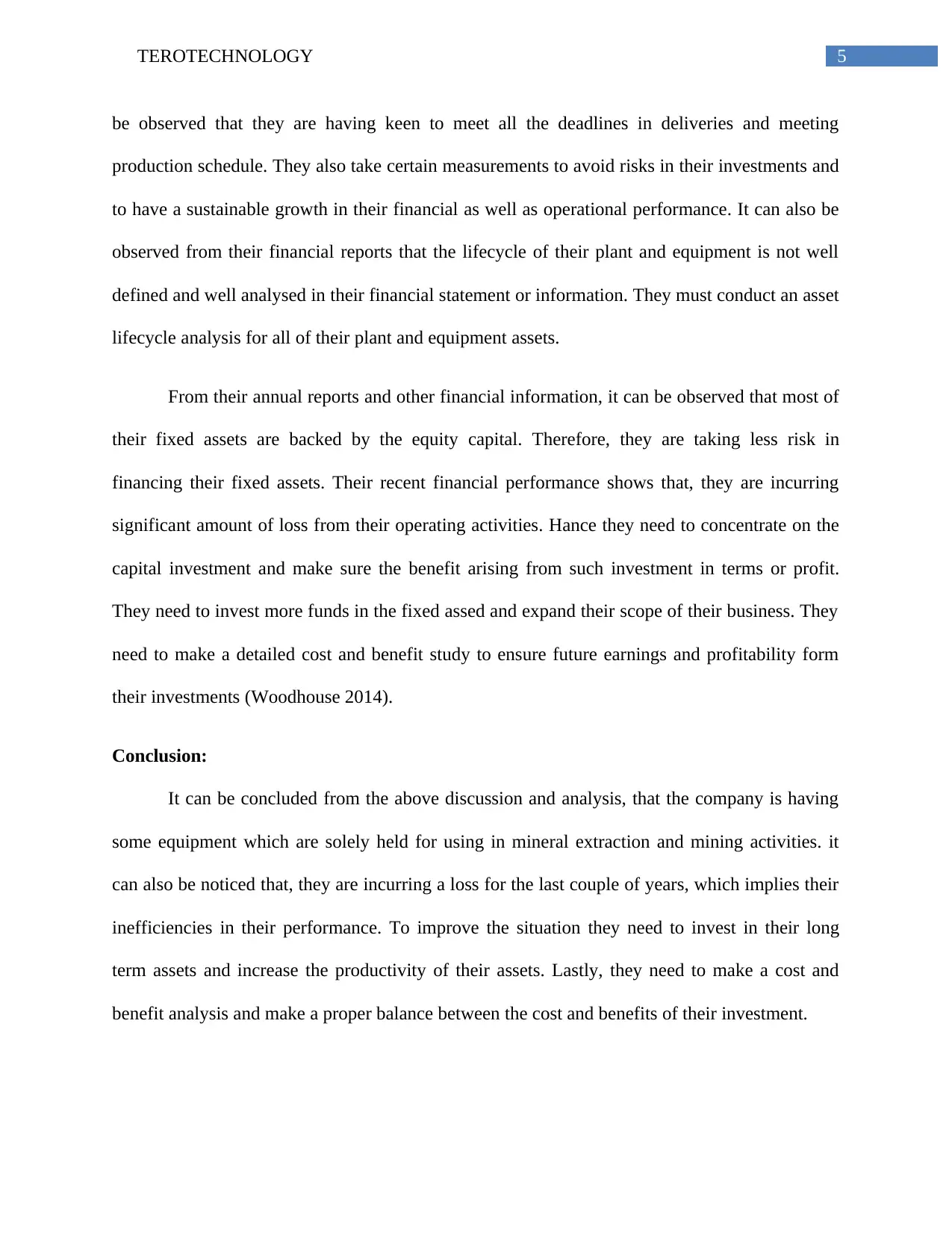
5TEROTECHNOLOGY
be observed that they are having keen to meet all the deadlines in deliveries and meeting
production schedule. They also take certain measurements to avoid risks in their investments and
to have a sustainable growth in their financial as well as operational performance. It can also be
observed from their financial reports that the lifecycle of their plant and equipment is not well
defined and well analysed in their financial statement or information. They must conduct an asset
lifecycle analysis for all of their plant and equipment assets.
From their annual reports and other financial information, it can be observed that most of
their fixed assets are backed by the equity capital. Therefore, they are taking less risk in
financing their fixed assets. Their recent financial performance shows that, they are incurring
significant amount of loss from their operating activities. Hance they need to concentrate on the
capital investment and make sure the benefit arising from such investment in terms or profit.
They need to invest more funds in the fixed assed and expand their scope of their business. They
need to make a detailed cost and benefit study to ensure future earnings and profitability form
their investments (Woodhouse 2014).
Conclusion:
It can be concluded from the above discussion and analysis, that the company is having
some equipment which are solely held for using in mineral extraction and mining activities. it
can also be noticed that, they are incurring a loss for the last couple of years, which implies their
inefficiencies in their performance. To improve the situation they need to invest in their long
term assets and increase the productivity of their assets. Lastly, they need to make a cost and
benefit analysis and make a proper balance between the cost and benefits of their investment.
be observed that they are having keen to meet all the deadlines in deliveries and meeting
production schedule. They also take certain measurements to avoid risks in their investments and
to have a sustainable growth in their financial as well as operational performance. It can also be
observed from their financial reports that the lifecycle of their plant and equipment is not well
defined and well analysed in their financial statement or information. They must conduct an asset
lifecycle analysis for all of their plant and equipment assets.
From their annual reports and other financial information, it can be observed that most of
their fixed assets are backed by the equity capital. Therefore, they are taking less risk in
financing their fixed assets. Their recent financial performance shows that, they are incurring
significant amount of loss from their operating activities. Hance they need to concentrate on the
capital investment and make sure the benefit arising from such investment in terms or profit.
They need to invest more funds in the fixed assed and expand their scope of their business. They
need to make a detailed cost and benefit study to ensure future earnings and profitability form
their investments (Woodhouse 2014).
Conclusion:
It can be concluded from the above discussion and analysis, that the company is having
some equipment which are solely held for using in mineral extraction and mining activities. it
can also be noticed that, they are incurring a loss for the last couple of years, which implies their
inefficiencies in their performance. To improve the situation they need to invest in their long
term assets and increase the productivity of their assets. Lastly, they need to make a cost and
benefit analysis and make a proper balance between the cost and benefits of their investment.
⊘ This is a preview!⊘
Do you want full access?
Subscribe today to unlock all pages.

Trusted by 1+ million students worldwide
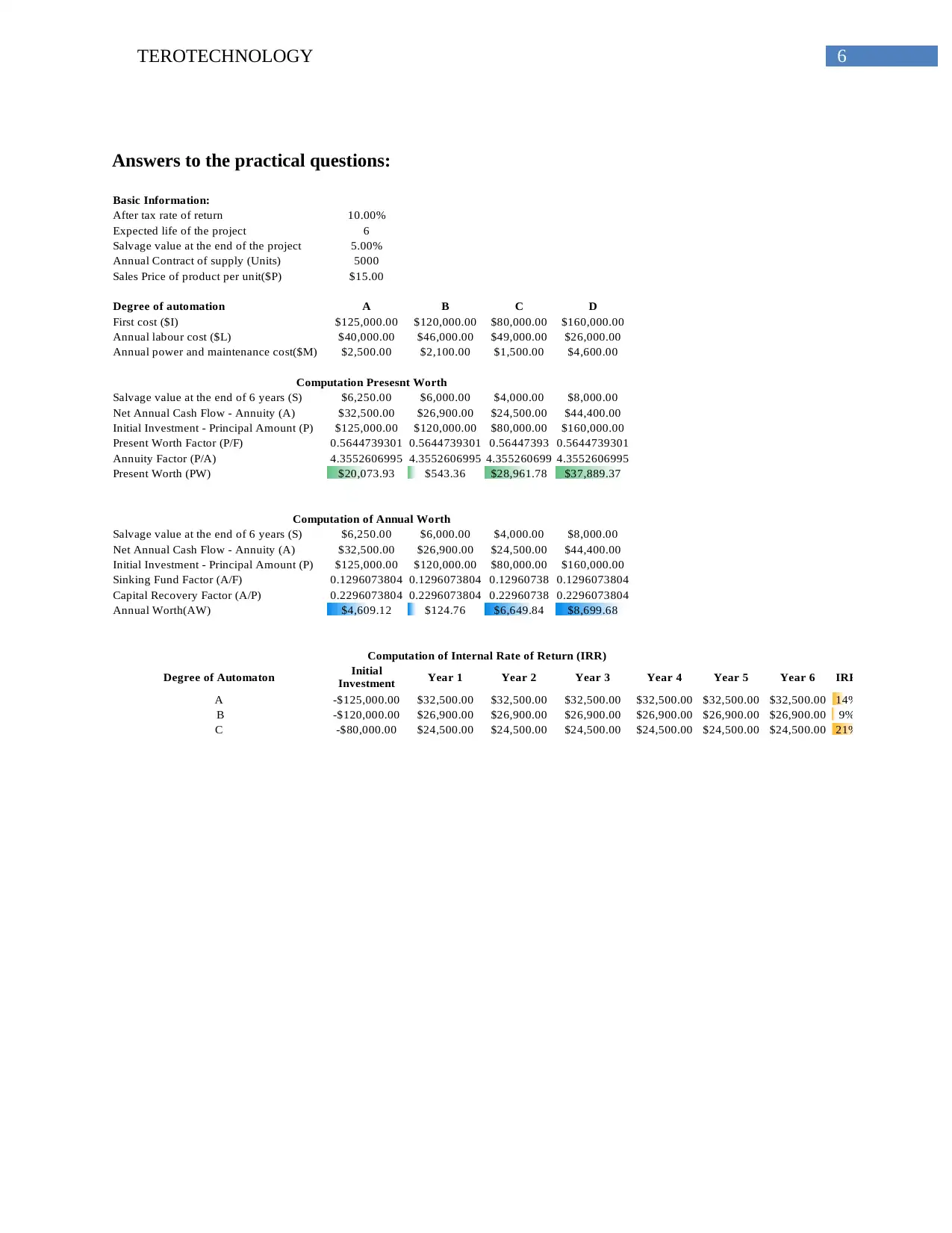
6TEROTECHNOLOGY
Answers to the practical questions:
Basic Information:
After tax rate of return 10.00%
Expected life of the project 6
Salvage value at the end of the project 5.00%
Annual Contract of supply (Units) 5000
Sales Price of product per unit($P) $15.00
Degree of automation A B C D
First cost ($I) $125,000.00 $120,000.00 $80,000.00 $160,000.00
Annual labour cost ($L) $40,000.00 $46,000.00 $49,000.00 $26,000.00
Annual power and maintenance cost($M) $2,500.00 $2,100.00 $1,500.00 $4,600.00
Computation Presesnt Worth
Salvage value at the end of 6 years (S) $6,250.00 $6,000.00 $4,000.00 $8,000.00
Net Annual Cash Flow - Annuity (A) $32,500.00 $26,900.00 $24,500.00 $44,400.00
Initial Investment - Principal Amount (P) $125,000.00 $120,000.00 $80,000.00 $160,000.00
Present Worth Factor (P/F) 0.5644739301 0.5644739301 0.56447393 0.5644739301
Annuity Factor (P/A) 4.3552606995 4.3552606995 4.355260699 4.3552606995
Present Worth (PW) $20,073.93 $543.36 $28,961.78 $37,889.37
Computation of Annual Worth
Salvage value at the end of 6 years (S) $6,250.00 $6,000.00 $4,000.00 $8,000.00
Net Annual Cash Flow - Annuity (A) $32,500.00 $26,900.00 $24,500.00 $44,400.00
Initial Investment - Principal Amount (P) $125,000.00 $120,000.00 $80,000.00 $160,000.00
Sinking Fund Factor (A/F) 0.1296073804 0.1296073804 0.12960738 0.1296073804
Capital Recovery Factor (A/P) 0.2296073804 0.2296073804 0.22960738 0.2296073804
Annual Worth(AW) $4,609.12 $124.76 $6,649.84 $8,699.68
Computation of Internal Rate of Return (IRR)
Degree of Automaton Year 1 Year 2 Year 3 Year 4 Year 5 Year 6 IRR
A -$125,000.00 $32,500.00 $32,500.00 $32,500.00 $32,500.00 $32,500.00 $32,500.00 14%
B -$120,000.00 $26,900.00 $26,900.00 $26,900.00 $26,900.00 $26,900.00 $26,900.00 9%
C -$80,000.00 $24,500.00 $24,500.00 $24,500.00 $24,500.00 $24,500.00 $24,500.00 21%
Initial
Investment
Answers to the practical questions:
Basic Information:
After tax rate of return 10.00%
Expected life of the project 6
Salvage value at the end of the project 5.00%
Annual Contract of supply (Units) 5000
Sales Price of product per unit($P) $15.00
Degree of automation A B C D
First cost ($I) $125,000.00 $120,000.00 $80,000.00 $160,000.00
Annual labour cost ($L) $40,000.00 $46,000.00 $49,000.00 $26,000.00
Annual power and maintenance cost($M) $2,500.00 $2,100.00 $1,500.00 $4,600.00
Computation Presesnt Worth
Salvage value at the end of 6 years (S) $6,250.00 $6,000.00 $4,000.00 $8,000.00
Net Annual Cash Flow - Annuity (A) $32,500.00 $26,900.00 $24,500.00 $44,400.00
Initial Investment - Principal Amount (P) $125,000.00 $120,000.00 $80,000.00 $160,000.00
Present Worth Factor (P/F) 0.5644739301 0.5644739301 0.56447393 0.5644739301
Annuity Factor (P/A) 4.3552606995 4.3552606995 4.355260699 4.3552606995
Present Worth (PW) $20,073.93 $543.36 $28,961.78 $37,889.37
Computation of Annual Worth
Salvage value at the end of 6 years (S) $6,250.00 $6,000.00 $4,000.00 $8,000.00
Net Annual Cash Flow - Annuity (A) $32,500.00 $26,900.00 $24,500.00 $44,400.00
Initial Investment - Principal Amount (P) $125,000.00 $120,000.00 $80,000.00 $160,000.00
Sinking Fund Factor (A/F) 0.1296073804 0.1296073804 0.12960738 0.1296073804
Capital Recovery Factor (A/P) 0.2296073804 0.2296073804 0.22960738 0.2296073804
Annual Worth(AW) $4,609.12 $124.76 $6,649.84 $8,699.68
Computation of Internal Rate of Return (IRR)
Degree of Automaton Year 1 Year 2 Year 3 Year 4 Year 5 Year 6 IRR
A -$125,000.00 $32,500.00 $32,500.00 $32,500.00 $32,500.00 $32,500.00 $32,500.00 14%
B -$120,000.00 $26,900.00 $26,900.00 $26,900.00 $26,900.00 $26,900.00 $26,900.00 9%
C -$80,000.00 $24,500.00 $24,500.00 $24,500.00 $24,500.00 $24,500.00 $24,500.00 21%
Initial
Investment
Paraphrase This Document
Need a fresh take? Get an instant paraphrase of this document with our AI Paraphraser
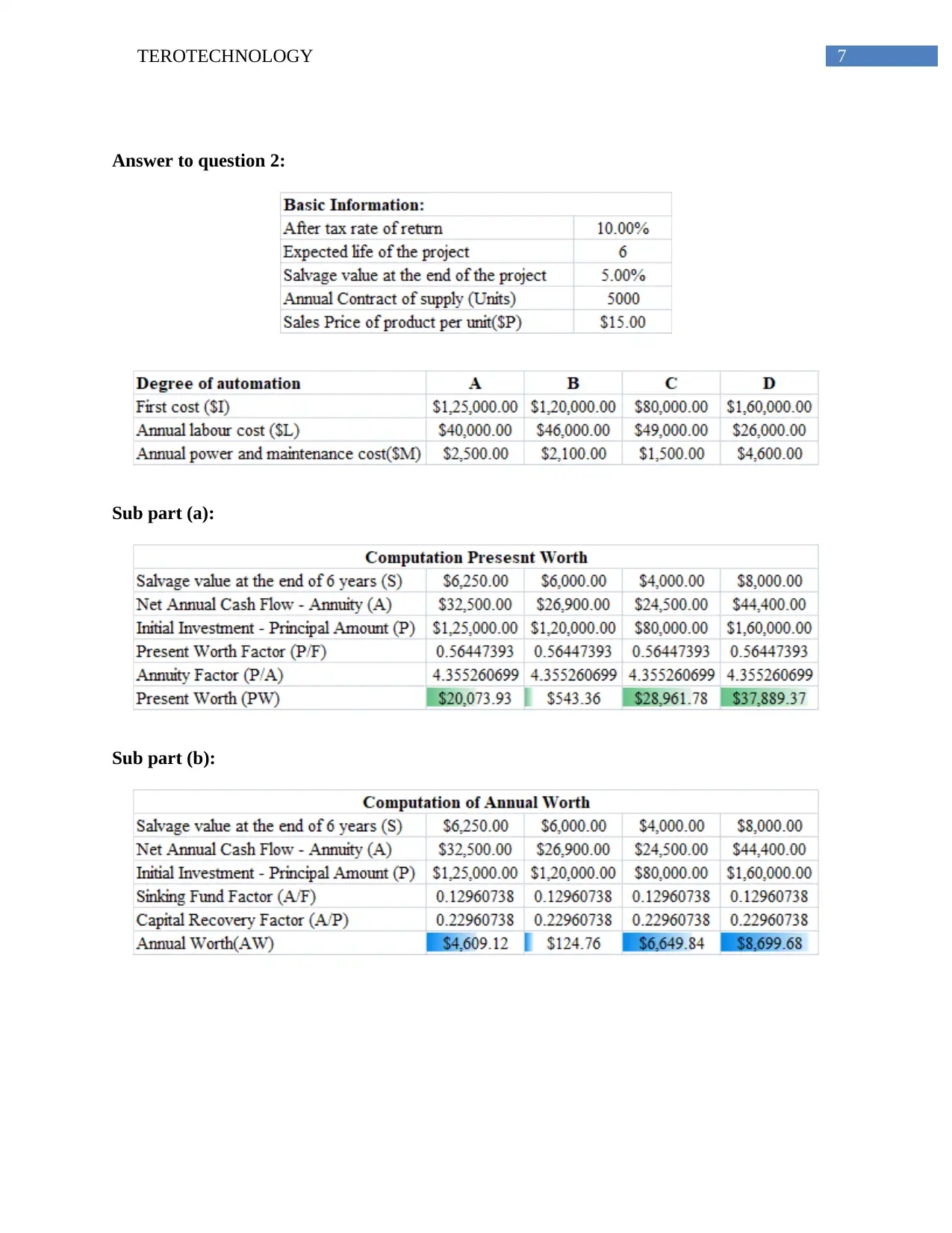
7TEROTECHNOLOGY
Answer to question 2:
Sub part (a):
Sub part (b):
Answer to question 2:
Sub part (a):
Sub part (b):
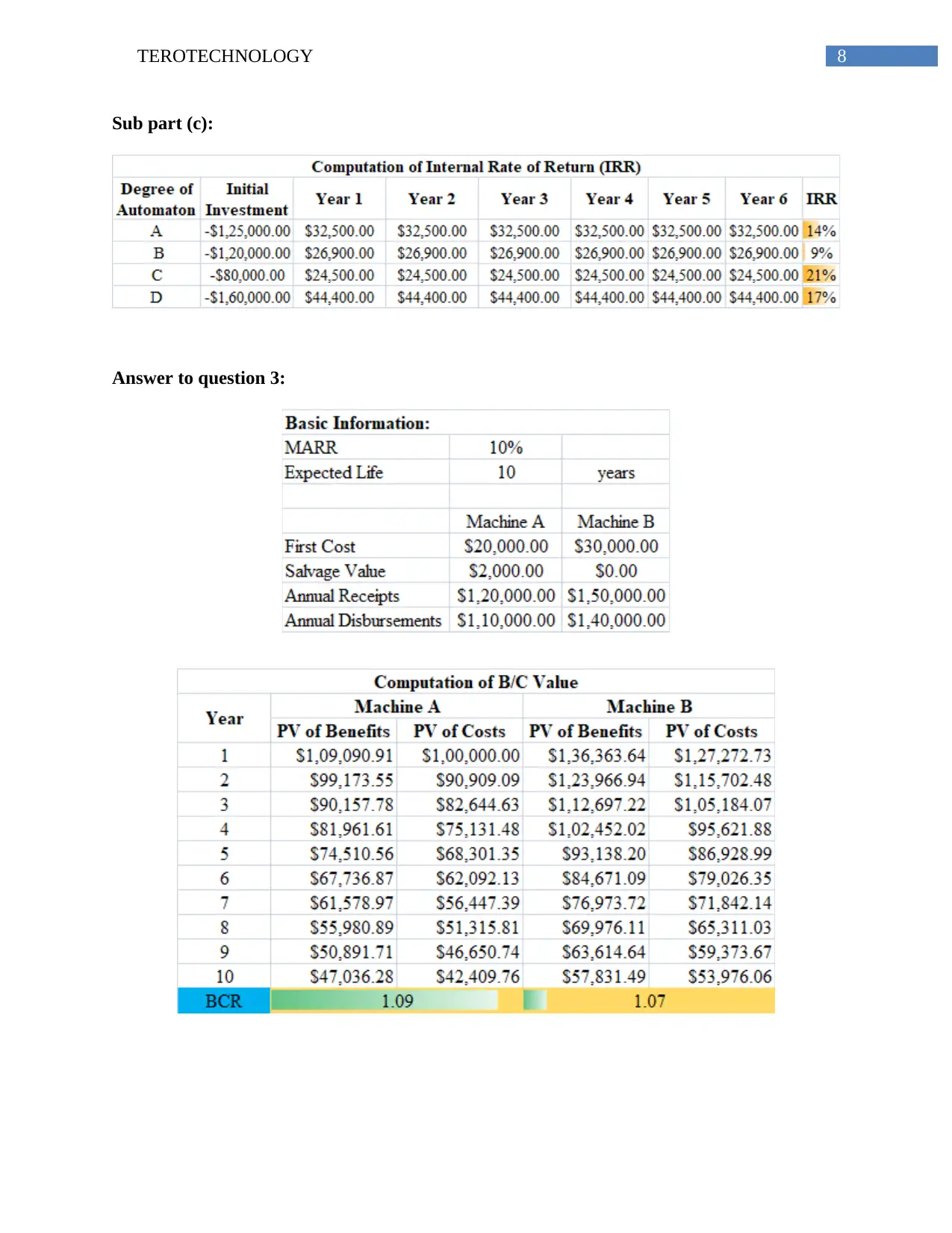
8TEROTECHNOLOGY
Sub part (c):
Answer to question 3:
Sub part (c):
Answer to question 3:
⊘ This is a preview!⊘
Do you want full access?
Subscribe today to unlock all pages.

Trusted by 1+ million students worldwide
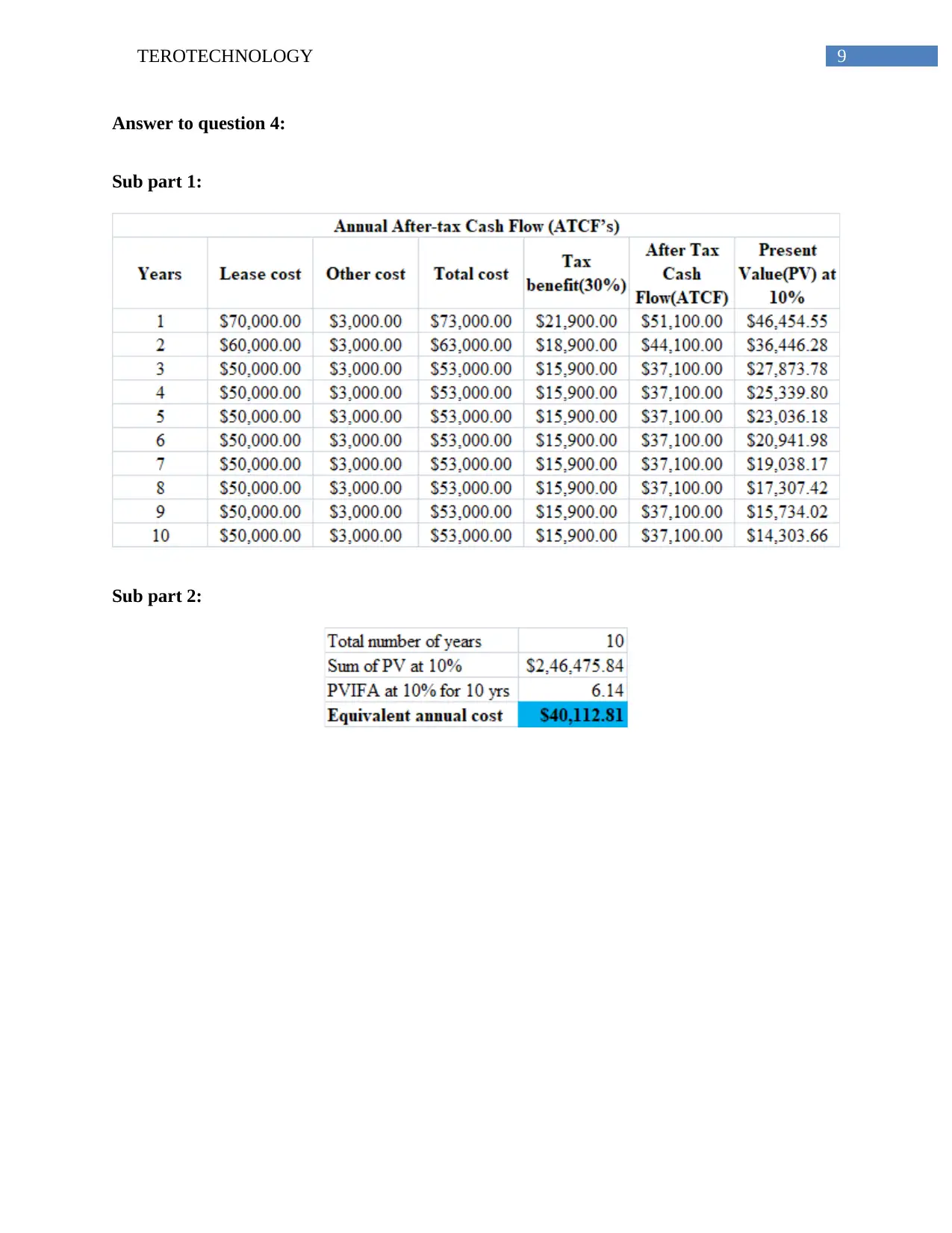
9TEROTECHNOLOGY
Answer to question 4:
Sub part 1:
Sub part 2:
Answer to question 4:
Sub part 1:
Sub part 2:
Paraphrase This Document
Need a fresh take? Get an instant paraphrase of this document with our AI Paraphraser
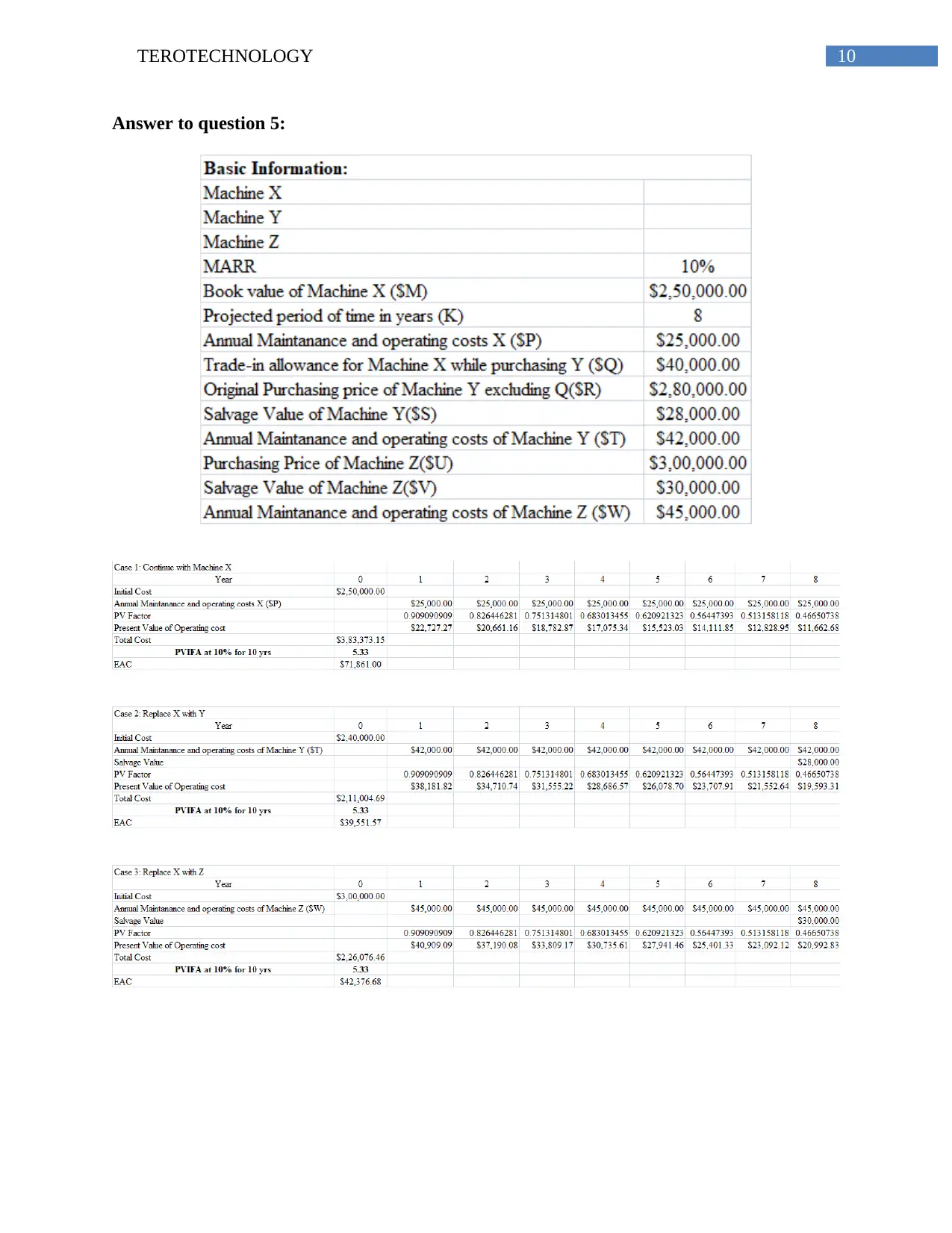
10TEROTECHNOLOGY
Answer to question 5:
Answer to question 5:
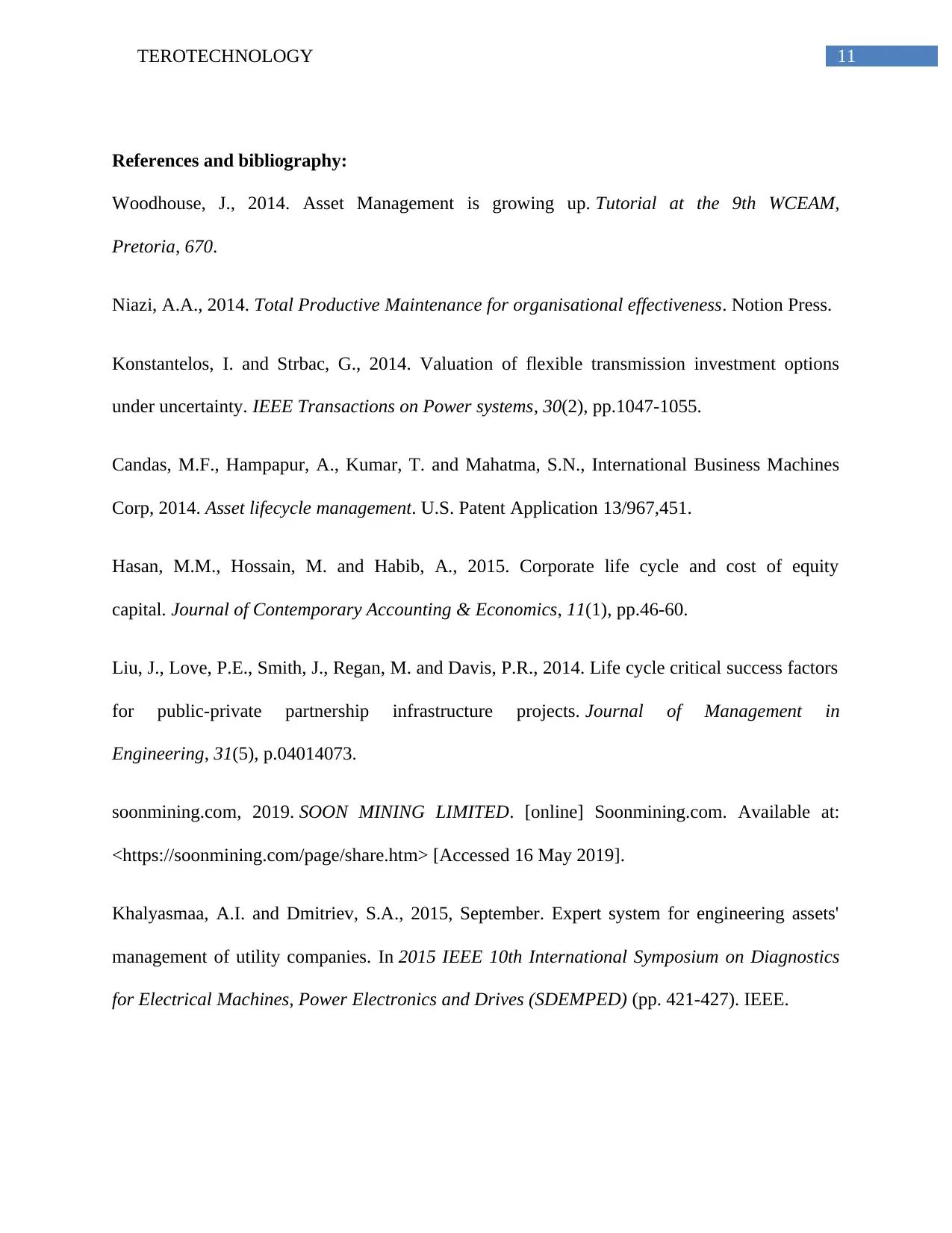
11TEROTECHNOLOGY
References and bibliography:
Woodhouse, J., 2014. Asset Management is growing up. Tutorial at the 9th WCEAM,
Pretoria, 670.
Niazi, A.A., 2014. Total Productive Maintenance for organisational effectiveness. Notion Press.
Konstantelos, I. and Strbac, G., 2014. Valuation of flexible transmission investment options
under uncertainty. IEEE Transactions on Power systems, 30(2), pp.1047-1055.
Candas, M.F., Hampapur, A., Kumar, T. and Mahatma, S.N., International Business Machines
Corp, 2014. Asset lifecycle management. U.S. Patent Application 13/967,451.
Hasan, M.M., Hossain, M. and Habib, A., 2015. Corporate life cycle and cost of equity
capital. Journal of Contemporary Accounting & Economics, 11(1), pp.46-60.
Liu, J., Love, P.E., Smith, J., Regan, M. and Davis, P.R., 2014. Life cycle critical success factors
for public-private partnership infrastructure projects. Journal of Management in
Engineering, 31(5), p.04014073.
soonmining.com, 2019. SOON MINING LIMITED. [online] Soonmining.com. Available at:
<https://soonmining.com/page/share.htm> [Accessed 16 May 2019].
Khalyasmaa, A.I. and Dmitriev, S.A., 2015, September. Expert system for engineering assets'
management of utility companies. In 2015 IEEE 10th International Symposium on Diagnostics
for Electrical Machines, Power Electronics and Drives (SDEMPED) (pp. 421-427). IEEE.
References and bibliography:
Woodhouse, J., 2014. Asset Management is growing up. Tutorial at the 9th WCEAM,
Pretoria, 670.
Niazi, A.A., 2014. Total Productive Maintenance for organisational effectiveness. Notion Press.
Konstantelos, I. and Strbac, G., 2014. Valuation of flexible transmission investment options
under uncertainty. IEEE Transactions on Power systems, 30(2), pp.1047-1055.
Candas, M.F., Hampapur, A., Kumar, T. and Mahatma, S.N., International Business Machines
Corp, 2014. Asset lifecycle management. U.S. Patent Application 13/967,451.
Hasan, M.M., Hossain, M. and Habib, A., 2015. Corporate life cycle and cost of equity
capital. Journal of Contemporary Accounting & Economics, 11(1), pp.46-60.
Liu, J., Love, P.E., Smith, J., Regan, M. and Davis, P.R., 2014. Life cycle critical success factors
for public-private partnership infrastructure projects. Journal of Management in
Engineering, 31(5), p.04014073.
soonmining.com, 2019. SOON MINING LIMITED. [online] Soonmining.com. Available at:
<https://soonmining.com/page/share.htm> [Accessed 16 May 2019].
Khalyasmaa, A.I. and Dmitriev, S.A., 2015, September. Expert system for engineering assets'
management of utility companies. In 2015 IEEE 10th International Symposium on Diagnostics
for Electrical Machines, Power Electronics and Drives (SDEMPED) (pp. 421-427). IEEE.
⊘ This is a preview!⊘
Do you want full access?
Subscribe today to unlock all pages.

Trusted by 1+ million students worldwide
1 out of 14
Related Documents
Your All-in-One AI-Powered Toolkit for Academic Success.
+13062052269
info@desklib.com
Available 24*7 on WhatsApp / Email
![[object Object]](/_next/static/media/star-bottom.7253800d.svg)
Unlock your academic potential
Copyright © 2020–2025 A2Z Services. All Rights Reserved. Developed and managed by ZUCOL.





